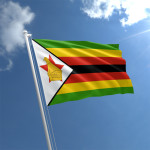On the 18th April 1980 Zimbabwe was granted independence from the United Kingdom and a new national flag was adopted.
The flag of Zimbabwe carries political, cultural and regional meanings. The Zimbabwe flag consists of five different colours – green, gold, red, black and white. Green represents the agricultural and rural landscape of Zimbabwe. Yellow stands for the wealth of minerals in the country, mainly gold. Red represents the blood shed during the two Chimurenga (the two struggles for independence in the 1890s and 1970s). Black stands for the heritage, race and ethnicity of the black majority. White is a symbol of peace.
The Zimbabwe flag has seven horizontal lines of green, gold, red and black with a white triangle on the left. The triangle contains a red 5-pointed star with a Zimbabwe bird in the middle. The red star symbolises socialism and the revolutionary struggles. The Zimbabwe bird is the national emblem – this represents a statue of a bird found at the ruins of the Great Zimbabwe (a ruined city found in the south east of Zimbabwe dating from the Iron Age).
Zimbabwe was known as Southern Rhodesia or Rhodesia (named after its founder Cecil Rhodes) from 1895 to 1980. It was ruled by the British South African Company from 1895 until 1923 when it became a self-governing British colony. A national flag was adopted in 1923. The flag of Southern Rhodesia consisted of a blue ensign with the Union Jack in the canton. The coat of arms featured on the flag was intended to be symbolic of Southern Rhodesia. The lion and thistle came from the coat of arms of Cecil Rhodes and the yellow pick on a green background stood for the mining and farming of the country. The flag changed again in 1953 due to political changes. Southern Rhodesia joined with Northern Rhodesia (now Zambia) and Nyasaland (now Malawi) to become the Federation of Rhodesia and Nyasaland. This new flag was used until 31st December 1963 when the federation was dissolved. The flag consisted of a blue ensign with the union jack in the canton. The shield featured on the flag consisted of a rising sun, taken from the Arms of Nyasaland, a lion rampant from the flag of Southern Rhodesia and black and white wavy lines from the Arms of Northern Rhodesia.
In 1964 a new flag was adopted again. The flag was sly blue in colour with a Union Jack canton. The Southern Rhodesia coat of arms was also included in the flag. This flag was used from 1964 to 1968. In November 1968, the mainly white government, declared independence from the United Kingdom and a new national flag was adopted. Southern Rhodesia became Rhodesia. The new flag consisted of a green, white, green triband with the full coat of arms placed in the centre. The coat of arms featured the lion and thistle from Cecil Rhodes’ family coat of arms, a gold pick on a green field representing the mining heritage and the Zimbabwe bird. The motto ‘Sit Nomine Digna’ (May it be Worthy of the Name) also featured. This was the first national flag to contain the Zimbabwe bird. In 1979 the country became Zimbabwe-Rhodesia and a new flag was adopted on 2nd September 1979. The new flag featured the pan-African colours of red, black, yellow and green and the Zimbabwe bird. The black stripe symbolised the black majority rule of the country, the red represented the struggle to achieve this, green for the country’s mineral wealth, a thin white stripe symbolising the white minority rule and a horizontal white band representing peace. This flag was used until 18th April 1980 when Zimbabwe gained full independence and the flag we see today was adopted.
For more information on historical Rhodesia flags click here.
Here at The Flag Shop we have a great range of Zimbabwe flags for sale, including flags in various sizes, hand flags, table flags and bunting. As our customer reviews show, we are the most trusted and reliable Flag Seller in the UK, so if you are looking to buy Zimbabwe flag look no further!
















